sales@intentmarketresearch.com
+1 463-583-2713
Computer-Aided Design (CAD) Market Size Analysis, By Component (Software and Services), By Design (3D & 2D), By Deployment (Cloud, On-Premise), By Application (3D Printing, Assembly, Surface Modeling, Reverse Engineering, Drafting, Detailing), By Industry (Electrical & Electronics, Healthcare, Automotive, Manufacturing, Media & Entertainment) and By Region; Global Insights & Forecast (2024 - 2030)
As per Intent Market Research, the Computer-Aided Design (CAD) Market was valued at USD 8.4 billion in 2023-e and will surpass USD 21.1 billion by 2030; growing at a CAGR of 14.9% during 2024–2030. The CAD market is driven by the increasing adoption of 3D printing technology.
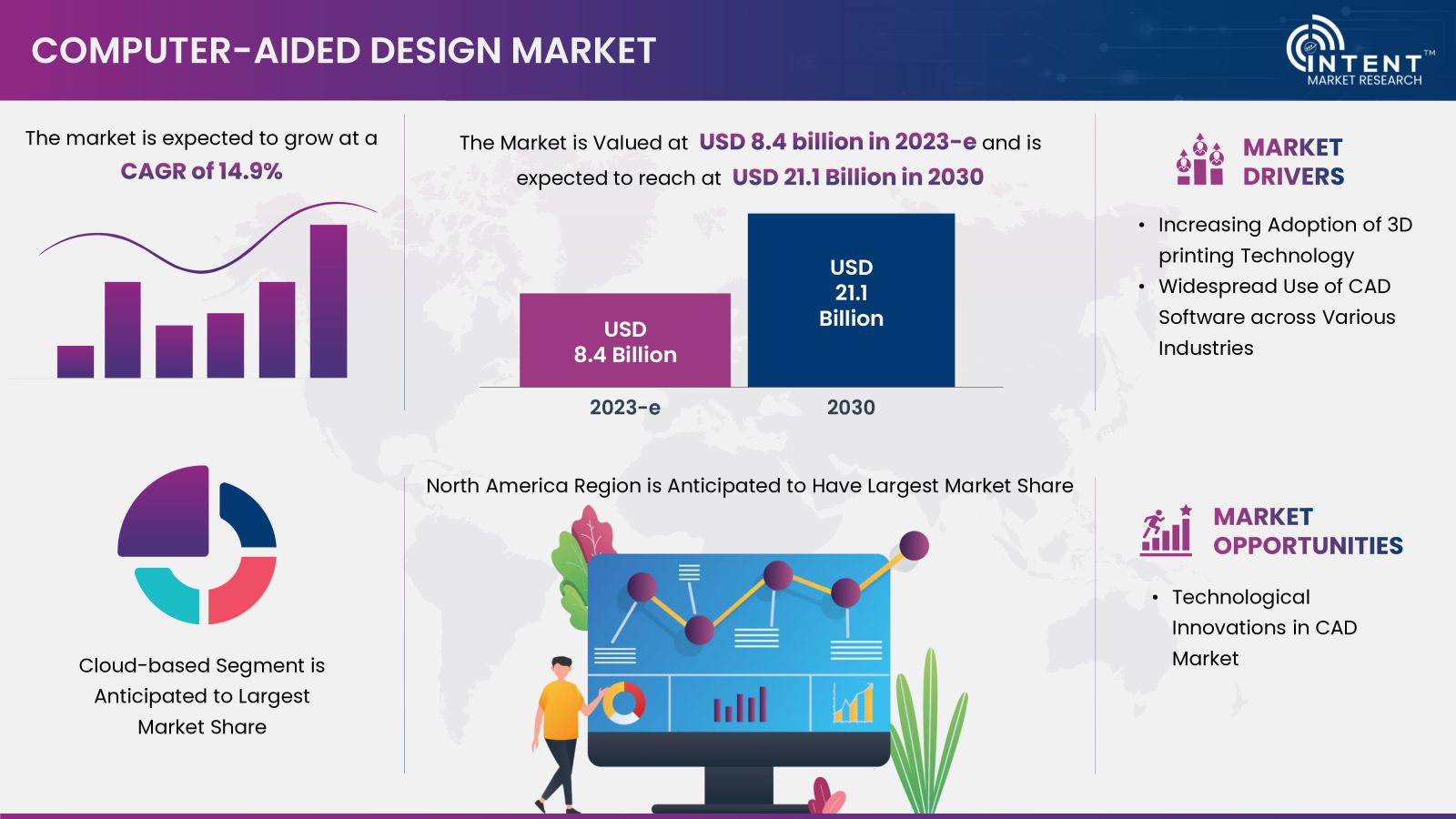
Click here to: Get FREE Sample Pages of this Report
Computer-Aided Design (CAD) is a technology that utilizes computer software and hardware to assist in the creation, modification, analysis, and optimization of designs and drawings for various applications, such as engineering, architecture, manufacturing, and product development. CAD software allows designers, engineers, and architects to create detailed and precise two-dimensional (2D) or three-dimensional (3D) models of objects, structures, or systems.
CAD software offers a wide range of tools and features for drawing, drafting, and modeling, to improve the design process by increasing accuracy, reducing errors, and saving time. In conclusion, CAD plays a crucial role in various industries, helping professionals create and refine designs with greater precision and flexibility than traditional manual drafting methods.
Computer-Aided Design (CAD) Market Dynamics
The CAD market is witnessing robust growth due to the increasing adoption of 3D printing technology. This innovative approach revolutionizes product design and prototyping, making CAD software an indispensable tool for engineers and designers. The market for CAD software experiences additional momentum through its widespread adoption across diverse industries such as automotive, aerospace, and architecture. This adoption is driven by its capacity to enhance precision, efficiency, and creativity in both design and manufacturing processes. These factors collectively drive the CAD market's prominence and continued advancement. Technological advancements, such as the integration of artificial intelligence in the CAD market, drive its growth. Despite this, the high cost of the software serves as a hindrance to the CAD market.
Widespread Use of CAD Software Across Various Industries
The widespread integration of CAD software is a hallmark across diverse industries, signifying its pivotal role in modern design and engineering. From architecture and automotive to electronics and manufacturing, CAD software has become an indispensable tool, streamlining the design process and fostering innovation. Its versatile application allows professionals to create detailed and accurate models, enhance collaboration, and accelerate product development cycles. The seamless adaptability of CAD software across various sectors underscores its universal utility, empowering professionals to visualize, iterate, and bring their ideas to fruition with precision and efficiency
3D Printing Technology Adoption is Set to Drive the Market
The CAD software market held the majority of the share in 2023 as it serves as a sophisticated tool for creating design documentation and mechanical design. It automates the process of mechanical design, streamline and enhance the manufacturing and development processes. The CAD software generates comprehensive product diagrams and provides vital information about materials, tolerances, dimensions, and other essential details.
Analyzing 3D and 2D Design to Visualizes Objects
The 3D design market held the majority of the share in 2023. 3D design precisely represents and visualizes objects using a collection of points in three dimensions on the computer. 3D design segment finds applications for architects, mechanical engineers, electrical engineers, interior designers, and civil engineers.
The applications of 3D design are diverse, catering to the needs of professionals such as architects, mechanical engineers, electrical engineers, interior designers, and civil engineers. Moreover, the widespread adoption of 3D design signifies a growing demand for advanced visualization tools in diverse industries. The versatility of 3D design plays a pivotal role in shaping the CAD market's landscape, as it addresses the evolving needs of professionals across different disciplines. As industries continue to prioritize precision and immersive visualization in their design processes, the impact on the CAD market is expected to be substantial, with 3D design serving as a driving force behind its continued growth and innovation.
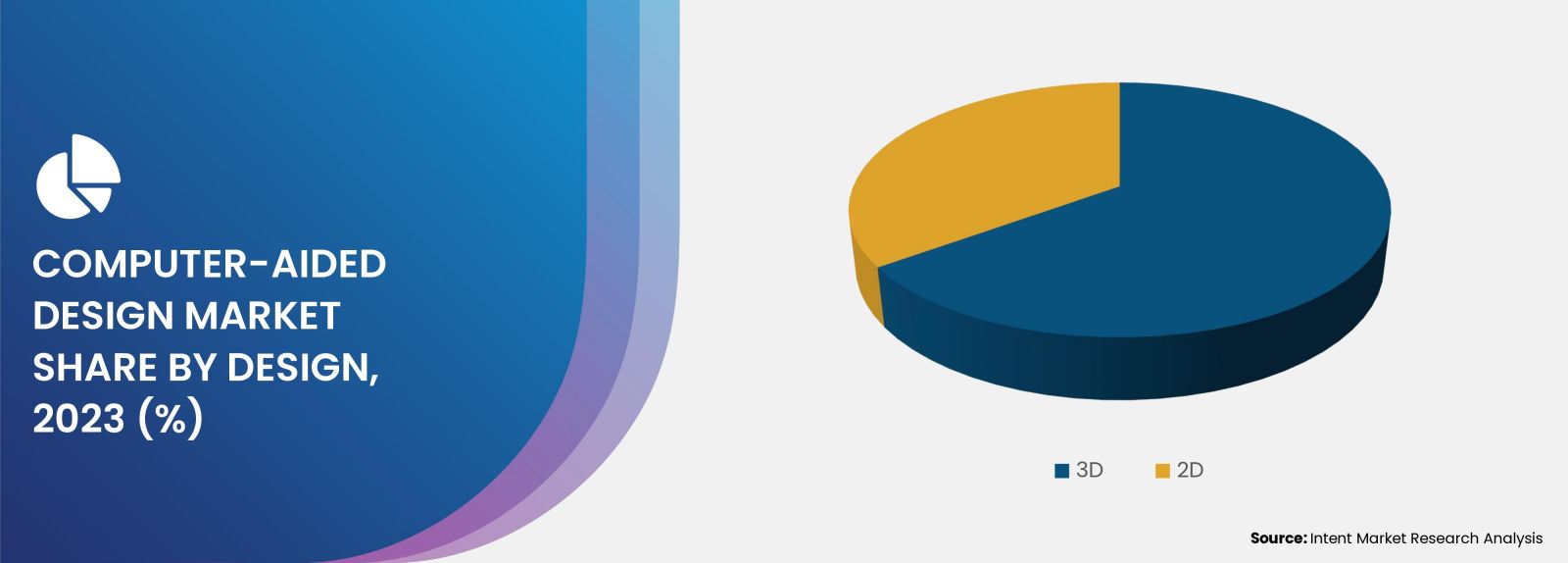
Ensuring Automatic Updates for Software by Cloud Deployment
The impact of cloud deployment on the CAD market is notable, with the cloud segment dominating the majority of the share in 2023. This shift can be attributed to the increasing preference for cloud solutions over on-premise alternatives. The adoption of cloud solutions is driven by their ability to deliver substantial cost savings in terms of hardware procurement. However, the transformative influence goes beyond cost efficiency, as cloud deployment introduces a crucial element to the CAD market.
One of the key advantages of cloud-based CAD solutions is the seamless and automatic updating of software. With software installed in the cloud, users can access and work on the latest versions without the need for manual updates or installations. As organizations across various sectors prioritize efficiency and responsiveness, the impact on the CAD market is significant, with cloud deployment emerging as a pivotal driver of growth and innovation.
Rising Interest in 3D Printing Segment and its Critical Role in Precision Manufacturing
The 3D printing segment held the majority of the share in 2023 due to its pivotal role in designing 3D printable components. CAD is an essential component of 3D printing as CAD file tells the 3D printer how much material it needs to deposit and where the material should be deposited. Without a CAD file, a 3D printer won’t have the instructions it needs to build a prototype or product. Hence, 3D printing segment is anticipated to boost the growth of the CAD market and thus creating opportunities for CAD software’s.
CAD Capabilities in Discrete Industry to Propel the Market Growth
CAD is extensively used in the conceptualization and design of automotive components, systems, and entire vehicles. Engineers and designers can create detailed 3D models of automotive parts, allowing for visualization, analysis, and refinement of designs before physical prototypes are produced. CAD software allows for simulations and analyses, such as finite element analysis (FEA) and computational fluid dynamics (CFD). These simulations help assess factors like structural integrity, thermal performance, aerodynamics, and crashworthiness, contributing to the overall safety and efficiency of vehicles.
Asia Pacific Market Poised for Rapid Expansion in the CAD Market
The Asia Pacific market is poised for rapid expansion throughout the forecast period, primarily driven by the increasing uptake of CAD software within various industries. This surge is expected to significantly contribute to the overall growth of the CAD market in the region. The robust expansion observed in Asia Pacific's engineering, design, and development sectors is forecasted to stimulate the adoption of advanced designing and modeling tools. Notably, substantial investments by leading healthcare equipment manufacturers in technological advancements underscore a growing emphasis on the integration of CAD designs for the development of medical devices within the region. Furthermore, the swift growth of the automotive industry is anticipated to be a key factor propelling the CAD market's expansion in the region. Japan, with its substantial share in the robotics and mechatronics industry, is poised to play a pivotal role in driving the growth of the CAD market within the country.
Key Developments
The market for CAD is characterized by intense competition due to the presence of numerous international and domestic players. The CAD market, in particular, is dominated by key players such as Autodesk, Caddie Software, Cadonix, Dassault, Fujifilm, Graebert, Nanosoft, PTC, Siemens, Trimble, and VariCAD, amongst others. These industry leaders are primarily focused on acquiring smaller players and innovating their product lines to cater to changing consumer preferences and needs. The success of players in the CAD market is heavily dependent on their ability to adapt to changing market trends and consumer preferences.
- In November 2023, Toray Advanced Computer Solution introduced a fashion CAD software package with 2D and 3D capabilities into the US market
- In May 2023, PTC announced its Creo software as a service CAD solution and the release of the tenth version of its Creo CAD software
- In April 2021, Autodesk acquired Up Chain, a product data management, product lifecycle management, instant-on, and cloud-based solutions provider, to offer value for suppliers, manufacturers, engineers, and other product stakeholders
- In November 2020, R2021x introduced the new 3DEXPERIENCE WORKS portfolio, bringing cloud benefits to the market and SOLIDWORKS customer
- In March 2023, VariCAD 2023-"2.0" a new version of VariCAD that contains updates in OpenGL settings. The company also updated the behavior of 2D objects, print settings, 3D object dragging, and configuration of usage of two monitors
Click here to: Get your custom research report today
CAD Market Coverage
The report provides key insights into the computer-aided design market, and it focuses on technological developments, trends, and initiatives taken by the government in this sector. The focus extends to market drivers, restraints, opportunities, and the analysis of key players and the competitive landscape within the computer-aided design market

Report Scope
|
Report Features |
Description |
|
Market Size (2023) |
USD 8.4 billion |
|
Forecast Revenue (2030) |
USD 21.1 billion |
|
CAGR (2024-2030) |
14.9% |
|
Base Year for Estimation |
2023-e |
|
Historic Year |
2022 |
|
Forecast Period |
2024-2030 |
|
Report Coverage |
Revenue Forecast, Market Dynamics, Competitive Landscape, Recent Developments |
|
Segments Covered |
By Component (Software and Services), By Design (3D & 2D), By Application (3D Printing, Assembly, Surface Modeling, Reverse Engineering, Detailing, Others), By Deployment (Cloud, On-Premise), By Industry (Electrical and Electronics, Healthcare, Automotive, Manufacturing, Media & Entertainment, Others) |
|
Regional Analysis |
North America (US, Canada), Europe (Germany, France, UK, Spain, Italy) Asia-Pacific (China, Japan, South Korea, India), Latin America (Brazil, Mexico, Argentina), Middle East & Africa (Saudi Arabia, South Africa, Turkey, United Arab Emirates) |
|
Competitive Landscape |
Autodesk, Caddie Software, Cadonix, Dassault, Fujifilm, Graebert, Nanosoft, PTC, Siemens, Trimble, and VariCAD, amongst others |
|
Customization Scope |
Customization for segments, region/country-level will be provided. Moreover, additional customization can be done based on the requirements. |
|
Purchase Options |
We have three licenses to opt for Single User License, Multi-User License (Up to 5 Users), Corporate Use License (Unlimited User and Printable PDF) |
|
1.Introduction |
|
1.1.Study Assumptions and Market Definition |
|
1.2.Scope of the Study |
|
2.Research Methodology |
|
3.Executive Summary |
|
4.Market Dynamics |
|
4.1.Market Growth Drivers |
|
4.1.1.Increasing Adoption of 3D Printing Technology |
|
4.1.2.Widespread Use of CAD Software Across Various Industries |
|
4.2.Market Growth Challenges |
|
4.2.1.High Cost of CAD Software |
|
4.3.Market Growth Opportunities |
|
4.3.1.Technological Innovations |
|
4.4.Porter’s Analysis |
|
4.5.PESTLE Analysis |
|
5.Market Outlook |
|
5.1.Overview (Industry Snapshot) |
|
5.2.Value Chain Analysis |
|
5.3.Supply Chain Analysis |
|
5.4.Regulatory Framework |
|
5.5.Technology Roadmap |
|
5.6.Patent Analysis |
|
5.7.CAD Trends |
|
5.8.CAD Market Opportunity |
|
5.9.Funding Analysis |
|
6.Market Segment Outlook (Market Size and Forecast by Value - USD billion, 2024 - 2030) |
|
6.1.Segment Synopsis |
|
6.2. By Component Type |
|
6.2.1.Software |
|
6.2.2.Services |
|
6.3.By Design Type |
|
6.3.1.3D |
|
6.3.2.2D |
|
6.4.By Deployment Type |
|
6.4.1.Cloud |
|
6.4.2.On-Premise |
|
6.5.By Application Type |
|
6.5.1.3D Printing |
|
6.5.2.Assembly |
|
6.5.3.Surface Modeling |
|
6.5.4.Detailing |
|
6.5.5.Others |
|
6.6.By End-use Industry |
|
6.6.1.Electrical and Electronics |
|
6.6.2.Healthcare |
|
6.6.3.Automotive |
|
6.6.4.Manufacturing |
|
6.6.5.Media & Entertainment |
|
6.6.6.Others |
|
7.Regional Outlook (Market Size and Forecast by Value - USD billion, 2024 - 2030) |
|
7.1.Global Market Synopsis |
|
7.2.North America |
|
7.2.1.North America CAD Market Outlook |
|
7.2.2.US |
|
7.2.2.1.US CAD Market, By Component |
|
7.2.2.2.US CAD Market, By Design Type |
|
7.2.2.3.US CAD Market, By Deployment |
|
7.2.2.4.US CAD Market, By Application |
|
7.2.2.5.US CAD Market, By Industry |
|
*Note: Cross-segmentation by segments for each country will be covered as shown above. |
|
7.2.3.Canada |
|
7.3.Europe |
|
7.3.1.Europe CAD Market Outlook |
|
7.3.2.Germany |
|
7.3.3.UK |
|
7.3.4.France |
|
7.3.5.Spain |
|
7.3.6.Italy |
|
7.4.Asia-Pacific |
|
7.4.1.Asia-Pacific CAD Market Outlook |
|
7.4.2.China |
|
7.4.3.India |
|
7.4.4.Japan |
|
7.4.5.South Korea |
|
7.4.6.Australia |
|
7.5.Latin America |
|
7.5.1.Latin America CAD Market Outlook |
|
7.5.2.Mexico |
|
7.5.3.Brazil |
|
7.6.Middle East & Africa |
|
7.6.1.Middle East & Africa CAD Market Outlook |
|
7.6.2.Saudi Arabia |
|
7.6.3.UAE |
|
8.Competitive Landscape |
|
8.1.Market Share Analysis |
|
8.2.Volume Output Analysis |
|
8.3.Company Strategy Analysis |
|
8.4.Competitive Matrix |
|
9.Company Profiles |
|
9.1. Autodesk |
|
9.1.1.Company Synopsis |
|
9.1.2.Company Financials |
|
9.1.3.Product/Service Portfolio |
|
9.1.4.Recent Developments |
|
9.1.5.Analyst Perception |
|
*Note: All the companies in the section 9.1 will cover same sub-chapters as above. |
|
9.2.Bentley Systems |
|
9.3.Caddie Software |
|
9.4.Cadonix |
|
9.5.Dassault |
|
9.6.Fujifilm |
|
9.7.Graebert |
|
9.8.Nanosoft |
|
9.9.PTC |
|
9.10.Siemens |
|
9.11.Trimble |
Let us connect with you TOC
Intent Market Research employs a rigorous methodology to minimize residual errors by carefully defining the scope, validating findings through primary research, and consistently updating our in-house database. This dynamic approach allows us to capture ongoing market fluctuations and adapt to evolving market uncertainties.
The research factors used in our methodology vary depending on the specific market being analyzed. To begin with, we incorporate both demand and supply side information into our model to identify and address market gaps. Additionally, we also employ approaches such as Macro-Indicator Analysis, Factor Analysis, Value Chain-Based Sizing, and forecasting to further increase the accuracy of the numbers and validate the findings.
Research Approach
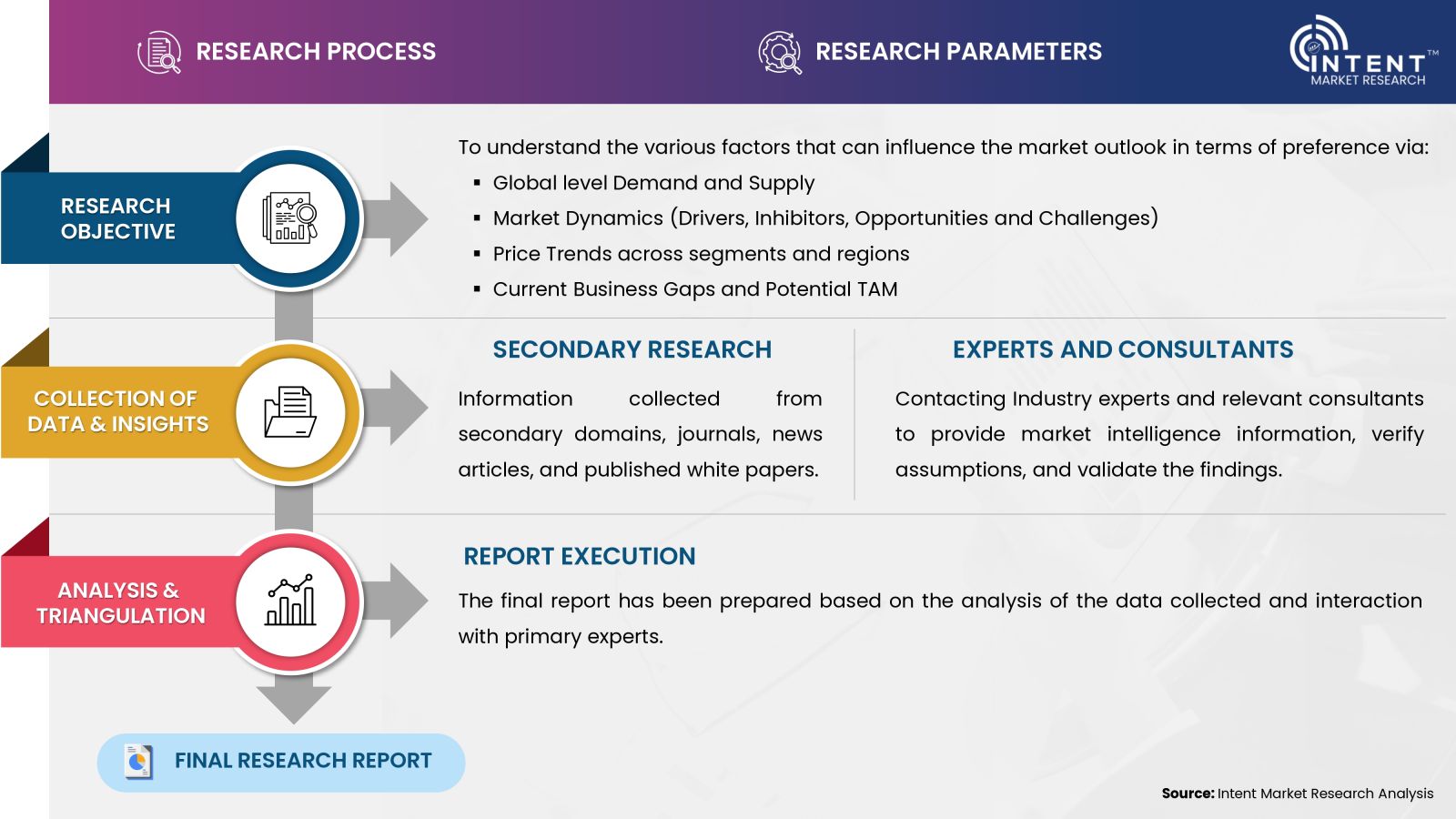
- Secondary Research Approach: During the initial phase of the research process, we acquire and accumulate extensive data continuously. This data is carefully filtered and validated through a variety of secondary sources.
- Primary Research Approach: Following the consolidation of data gathered through secondary research, we initiate a validation and verification process to verify all the market numbers and assumptions by engaging with the subject matter experts.
Data Collection, Analysis and Interpretation:
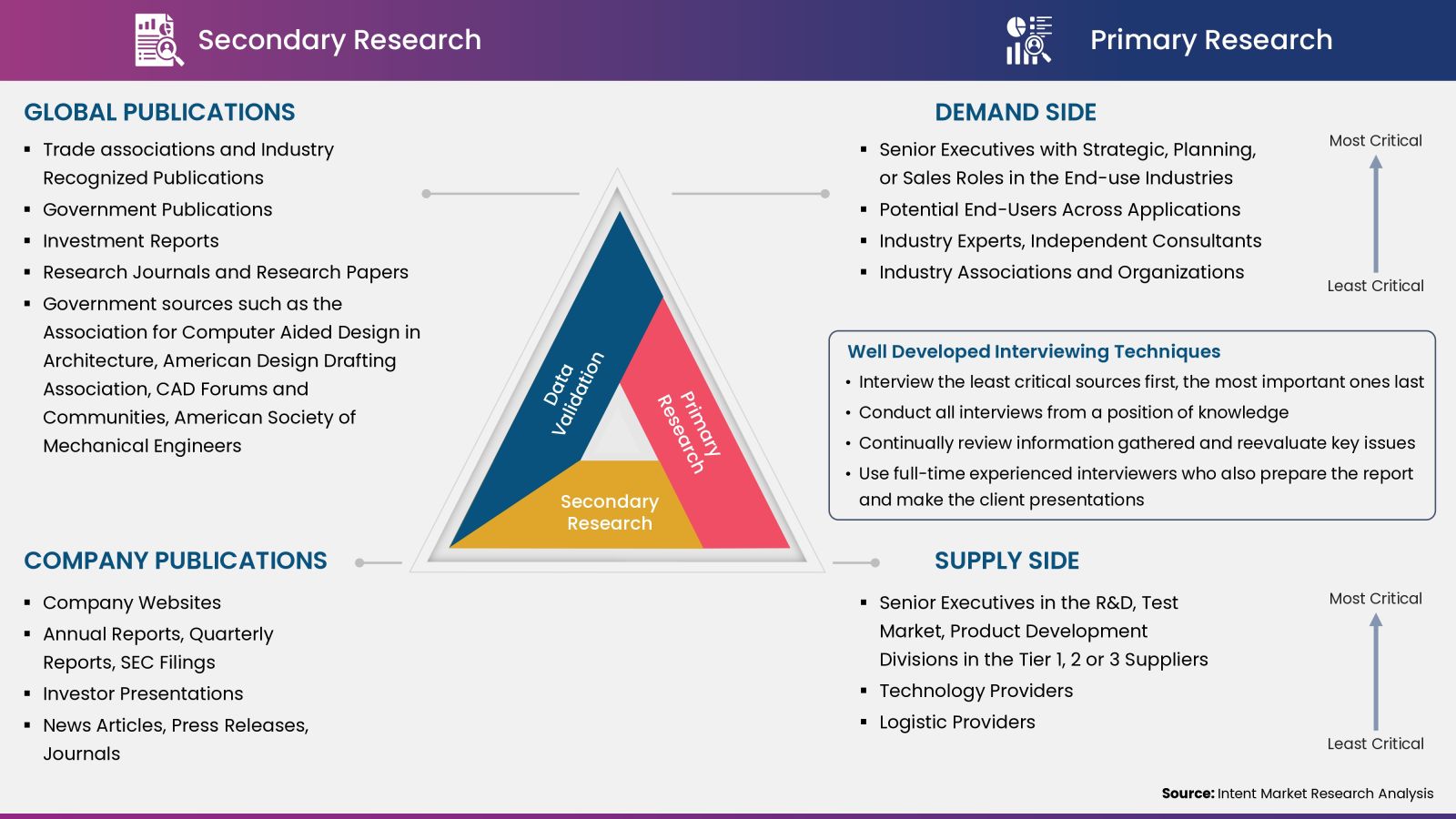
Research Methodology
Our market research methodology utilizes both top-down and bottom-up approaches to segment and estimate quantitative aspects of the market. We also employ multi-perspective analysis, examining the market from distinct viewpoints.
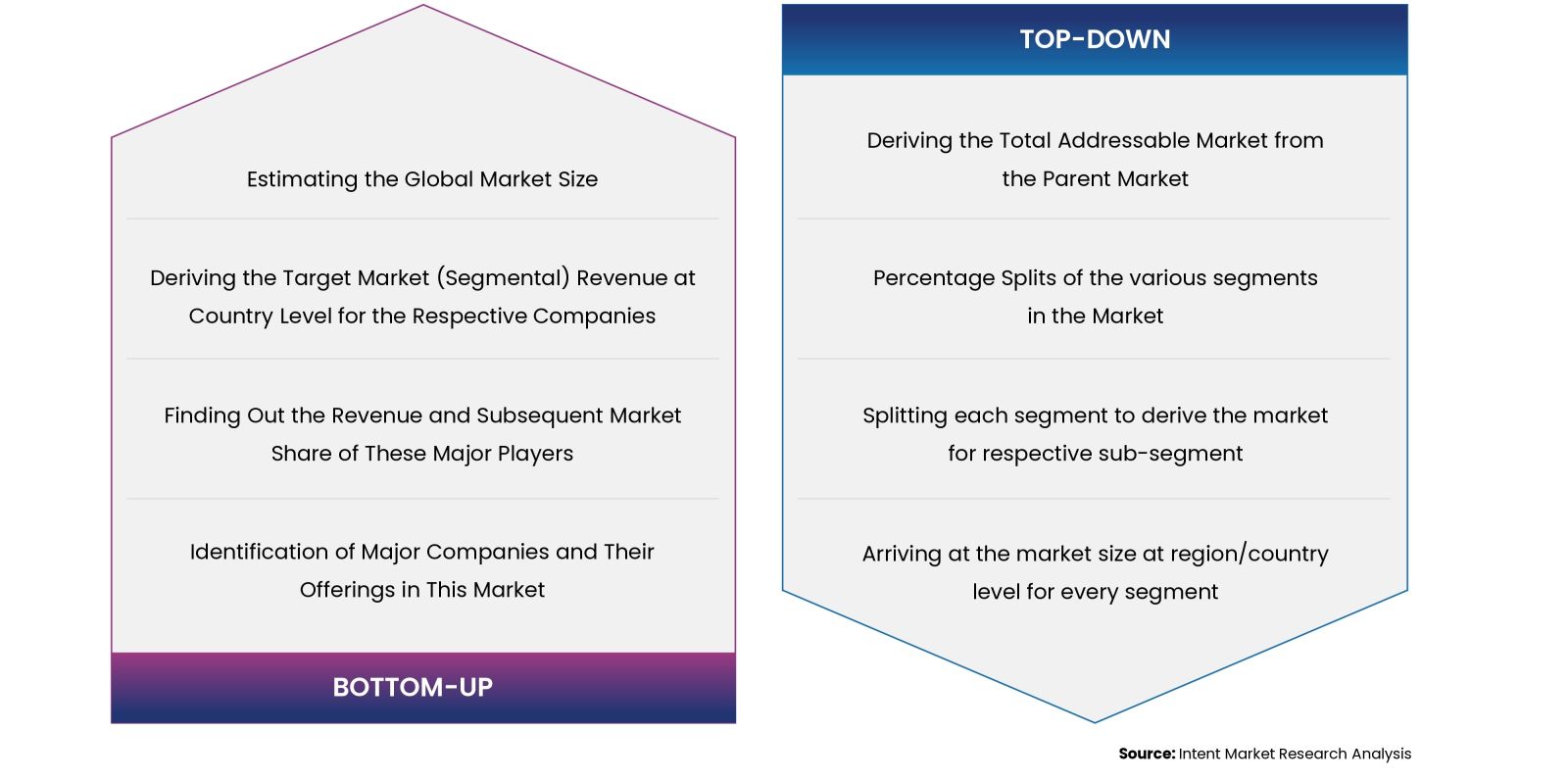
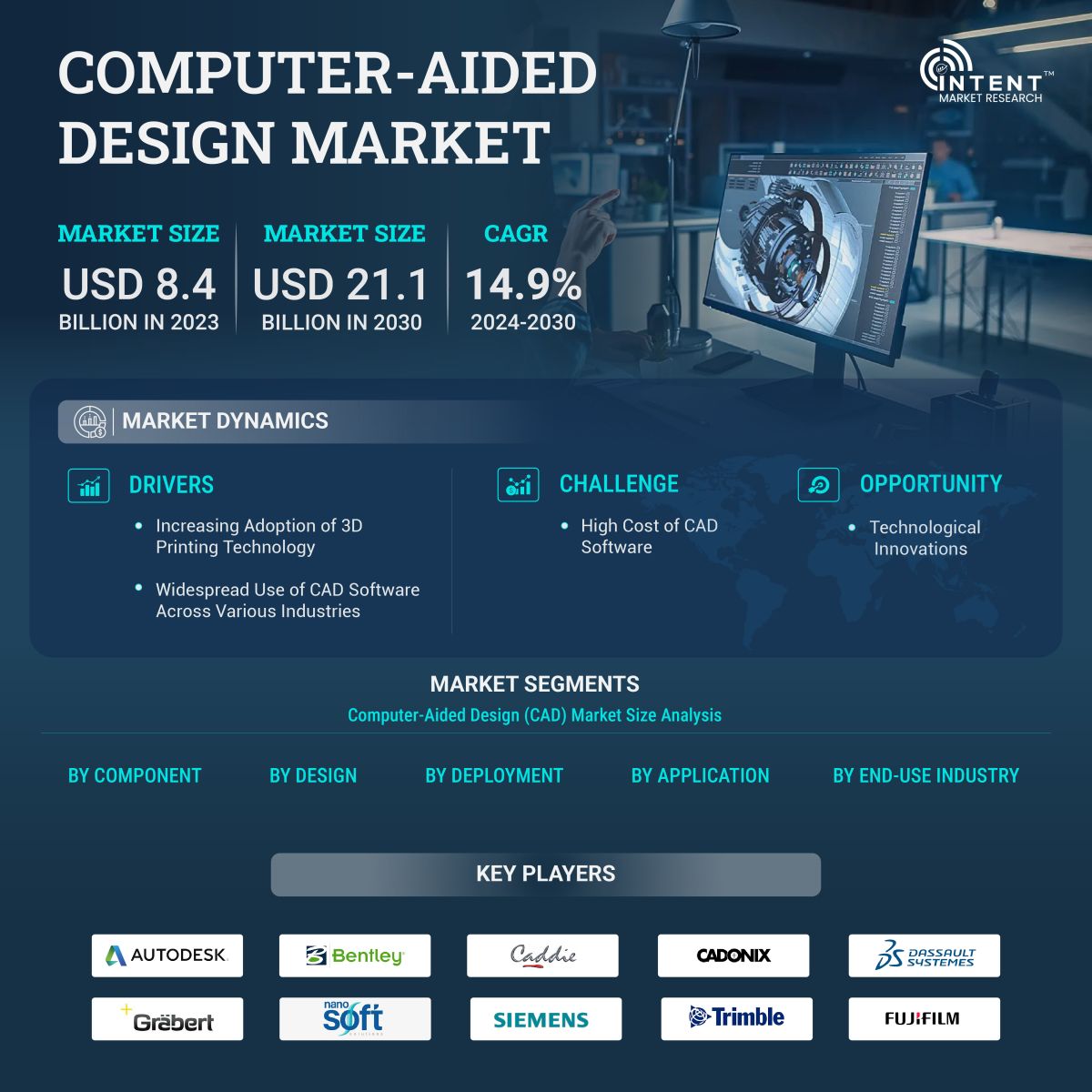
Available Formats


